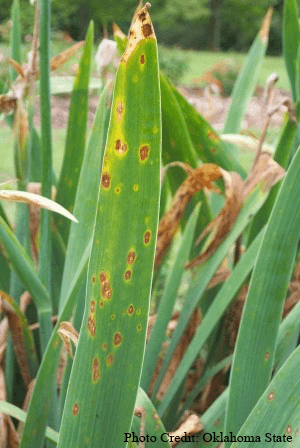What are those yellow spots on my Bearded Iris leaves?

Fungal Leaf Spot: Fungal Leaf Spot, caused by the pathogen Didymellina macrospora, is a common occurrence for all types of iris battling an unusually wet spring season. It primarily attacks the foliage, but may also infect the stalk and buds. Fungal Leaf Spot may affect all species of iris, but bearded iris seem to be most susceptible. Fungal Leaf Spot can greatly reduce the vigor of an iris and may result in death if the disease is allowed to progress year after year.
Signs & Symptoms: A few clues to help identify which pathogen may be affecting your iris are to note the shape and color of the lesions on the infected tissue. Fungal Leaf Spots are circular, or oval-shaped, first appearing as ⅛-¼” dark brown spots surrounded by a chlorotic water-soaked border. As the lesions enlarge they will show a distinct brownish-red outline.
Disease Environment: Fungal Leaf Spot develops and thrives in conditions with consistent moisture on the leaf surfaces, cool-mild temperatures, and poor air circulation. It spreads by water, wind, and contaminated tools and equipment not properly sanitized after coming into contact with infected debris.
Cultural Prevention: Above all, we first encourage growers to establish strong cultural techniques for preventing environments susceptible to this disease. Preventive techniques include planting your iris with adequate spacing to allow ample air circulation at approximately 12-24” apart and avoiding overhead irrigation as much as possible. Make sure neighboring plant foliage is not overcrowding your iris and keep up on the weeding! Plant your iris in locations with full sun and ensure the soil has excellent drainage.
Control Measures: Sanitation is the next best measure to reduce disease progression. Remove and dispose of up to ⅓ of infected foliage leaving some to remain to continue to photosynthesize. We recommend removing all the diseased foliage in the Autumn. Doing so should significantly reduce the number of spores that can survive the dormant season. If the disease is developing at a rapid rate, you may apply a foliar fungicide at 7-10 day intervals to help protect new growth. Contact your local garden center for their recommended fungicide options. Adding a surfactant such as ¼ tsp of Dr. Bronner’s castile soap per gallon will help the fungicide stick to the foliage. Be mindful of applications, timing them around the rain so they don’t quickly wash off. Be sure to read your product label carefully noting environmental hazards and the advised PPE. Fungicide applications are most successful when applied when the fans grow to 4-6” tall.




